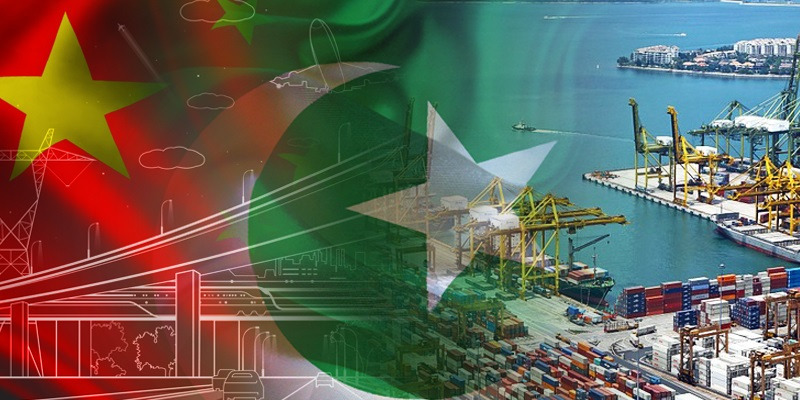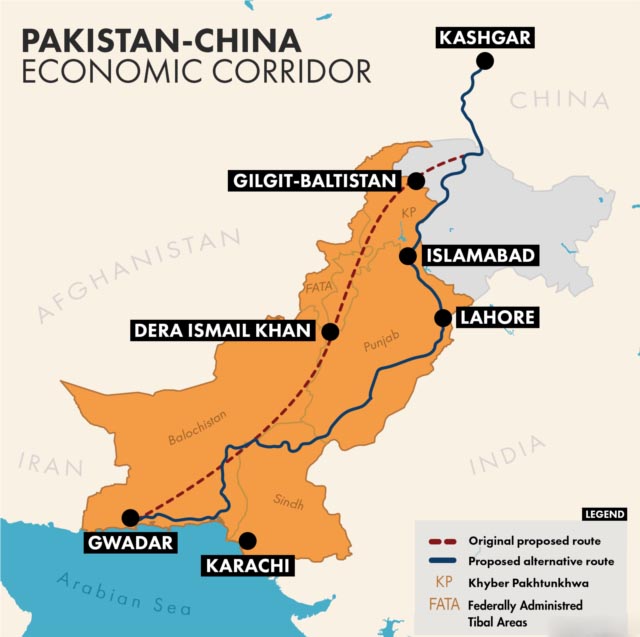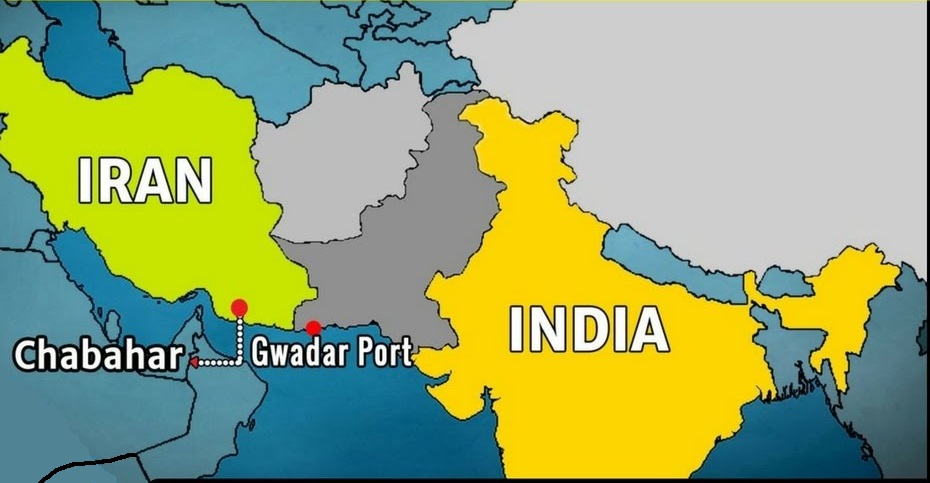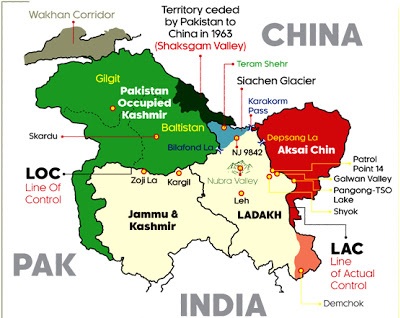
- Guided by its ambition of becoming ‘the’ dominant state in the world, China has systematically worked towards becoming a contender for superpower status.
- Xi Jinping has sought to cure the Malacca dilemma through the Belt and Road Initiative or BRI. At the same time, through its overland Silk Road Economic Belt’s flagship programme China Pakistan Economic Corridor or CPEC, China is seeking access to the Indian Ocean.
- China has smartly followed Chanakya’s Mandal theory and nurtured its relations with Pakistan because the neighbour’s neighbour and neighbour’s enemy are natural allies- India is sandwiched between vijigishu China and its natural ally Pakistan.
- If PoK is reintegrated with India, China would have to seek access to Pakistan through Afghanistan via the Wakhan corridor, or even through Tajikistan and Afghanistan.
- Considerable amount of political will is required on part of India to go through it because it would actually be in the middle of a two-front war, and China is an adversary to be reckoned with.
- Support must be extended to the pro-democracy voices in China because ultimately, democracy is the best protection against unjust wars and autocracy.
Opening statement of the recently declassified US Strategic Framework for Indo-Pacific or SFIP, interrogates how the US can maintain its primacy in the Indo-Pacific region while preventing China from enhancing its sphere of influence. This question underlines the current overarching scenario in world politics that is guiding international relations. As China makes moves towards replacing the USA as the primary hegemone, a position America is loath to give up, the world witnesses an undeclared Cold War.
The strategy document is based on stated assumptions that US security and prosperity depends on free and open access to the Indo-Pacific region, and US’ top interest lies in maintaining its primacy in the region. Evidently the biggest hindrance to this primacy is Beijing, which through its Belt and Road Initiative (BRI) has made strategic inroads in geographies with no previous Sino footprints.
Vijigishu China- Eyes on the Indian Ocean
In the Arthashastra, Kautilya describes ‘vijigishu’ as a sovereign looking to expand territory and sphere of influence. Guided by its ambition of becoming ‘the’ dominant state in the world, China has systematically worked towards becoming a contender for superpower status. Through easy loans and debt-traps, lucrative looking infrastructure development deals, strategic capital investments, and careful control of narrative, China has been able to woo many lesser developed nations, especially in Central Asia and Africa. Similarly, investments and promises for greater access to China’s market has been effectively utilized to make inroads in Europe.
The so-called pole-bearers of justice and human rights, European leaders far from taking any measures to contain China’s atrocities in Tibet and Xinjiang, have hesitated in even giving any strong statements against it, despite losing millions of their citizens to the Wuhan virus. The deliberate turning of a blind eye to China’s non-compliance with international rules/norms is due to various reasons. Primarily, Europe fears the loss of the huge market that China is, even though it is not fully accessible to them; secondly,China’s calculated investments in Europe’s media houses, education institutions, etc has granted Communist Party of China some hold over narratives in public.
In spite of China’s unprecedented expansionism, a major hindrance to its global ambition of being the ‘middle-kingdom’ is its lack of access to the Indian Ocean through which large portions of its trade and essential commodities’ supply flow. Xi Jinping has sought to cure the Malacca dilemma through the Belt and Road Initiative or BRI. The Maritime Silk Road or MSR seeks to build or acquire a network of ports, artificial islands and related infrastructural paraphernalia from South China sea to East coast of Africa. Some strategically significant acquisitions as Hambantota and Doraleh are already under China’s belt. At the same time, through its overland Silk Road Economic Belt’s flagship programme China Pakistan Economic Corridor or CPEC, China is seeking access to the Indian Ocean.
CPEC passes through Indian territory occupied by Pakistan, a part of which was handed over by Pakistan to China under the 1963 Sino-Pakistan Frontier Agreement, and ends at the Gwadar port in the western flank of the Indian Ocean.Once this corridor along with the port becomes fully functional, USA will lose a major leverage vis-à-vis China. Lack of direct access to the Indian ocean keeps China’s expansionist power projection considerably limited. Even with its greater than ever before footprints in Central Asia via its overland Silk road initiatives, China’s ambitions are constrained by geography. That is why China has officially emphasized the centrality of the Maritime Silk Road to the success of its Belt and Road Initiative.
Enemy’s enemy is a natural ally

On its part, China has smartly followed Chanakya’s Mandal theory and nurtured its relations with Pakistan because the neighbour’s neighbour and neighbour’s enemy are natural allies- India is sandwiched between vijigishu China and its natural ally Pakistan. Having recognized China as the primary competition now, the USA sees India as a natural ally by the same common sense.
While recognizing the persistence of USA-China strategic competition, SFIP clearly states that the USA intends to use India as a counterweight to China. An entire page of this 10-page document is dedicated to India, and helping India’s rise and capacity to serve as net security provider and major defence partner. To that end it proposes supporting India through all channels available, including diplomatic, military and intelligence in dealing with ‘continental challenges such as the border dispute with China and access to water…’.The strategy document underlines the need to maintain India’s pre-eminence in South Asia and for it to become the leading player in providing Indian Ocean security.
Key pieces on the board
The USA wants to restrict China’s growing influence and maintain its primacy in the Indian Ocean region. A functioning CPEC works directly against this objective. Without Gwadar in its kitty, China will have no way of achieving direct access to the Indian Ocean. One might argue that China has ownership of the Hambantota port, but India’s overbearing presence here along with US bases such as Diego Garcia, coupled with Sri Lanka’s distance from Chinese shores restricts China’s effective access.
Bangladesh follows a prudent foreign and economic policy. Even though it is a part of the BRI, Bangladesh has keenly avoided any deal that costs its national interests. For example- the China Harbour and Engineering Company, which built Hambantota, was blacklisted by Bangladesh over bribery allegations. The Sonadia deep sea port project with China was scrapped over environmental concerns. Besides, Bangladesh is surrounded on three sides with India, with which it shares good relations.The only access China has to Bangladesh while circumventing India is through Myanmar.So, China is unlikely to gain any major strategic foothold here.
The recent military coup in Myanmar should ring warning bells. It is always easier for Communist China to deal with autocratic regimes instead of democracies, obviously because it is easier to buy off a handful of rulers who are not responsible towards their people.
Notably, the recent military coup in Myanmar should ring warning bells. It is always easier for Communist China to deal with autocratic regimes instead of democracies, obviously because it is easier to buy off a handful of rulers who are not responsible towards their people. Although China maintains that it had better relations with the democratic government of Myanmar than with the military junta, accusations of Chinese support to the military are making rounds. It is worth mentioning here that several Chinese projects in Myanmar,for instance the Muse Mandalay rail project and the New Yangon City project, were put on hold because of local unrest, and also because the National League for Democracy government was wary of China’s debt trap. Out of the 38 projects China has proposed under the China Myanmar Economic Corridor or CMEC of the BRI, Myanmar has only approved nine. Under Aung San Suu Kyi, Myanmar’s debt to China reduced by 26 per cent. Having said that, it must also be remembered that it was President Thein Sein who not only stopped work at Myitsone Dam, but also cancelled the Yunan-Kyaw Phyu rail project, citing the people’s will. Even in the ongoing protests, several Chinese factories and shops have been targeted and damaged by the protestors, and their placards say ‘China get out of Burma’, and ‘China supports military coup’.Whether or not China has a hand in this coup, and whether it is able to make use of this situation to make strategic inroads via Myanmar into the Indian Ocean will be clear soon. China is also known to exercise influence over Rohingya separatists.
Pakistan’s neighbour Iran is also a key piece of this geo-political game. The Trump administration’s policies left Iran with no alternative but to turn towards China. However, prior to this complexity, India and Iran’s investment deal with respect to the Chabahar port speaks volumes about Iranian intentions. Post-sanctions developments have resulted in Chinese investment in the Chabahar-Zahedan railway project. But, even if China were to acquire control of Chabahar, it would still have to fiddle with similar geographical constraints as with Hambantota. So, China’s only realistic hopes lie with CPEC and Gwadar.
Strategic policy options

For the USA’s declared interest in maintaining strategic primacy in Indo-Pacific region, restricting China’s access to Indian Ocean is crucial, and for that it cannot allow the 62-billion-dollar CPEC running from Kashgar to Gwadar. There is more than one way to achieve this end, and a combination of policies mentioned below is plausible.
One way is to fuel prevailing local unrest and resentment against Chinese constructions and PLA’s high-handedness. China’s disregard for the environment in pushing this project forward is well known. The population displaced due to the construction of the port, roads, mining activities, dams etc has been protesting against loss of livelihood and demanding for basic amenities like water and sanitation facilities. For instance, fishing communities in Gwadar are protesting against displacement, Muzaffarabad is protesting against the Kohala Dam project. There have been reports of Pakistani workers getting lower wages than their Chinese counterparts, against which thousands of Pakistani labourers protested in Karachi in November last year. PoK itself has been witnessing protests against PLA building roads to move artillery and military personnel in the region. A recent massive blackout in Pakistan has been attributed to China’s malpractices in the power sector. The people of Pakistan are beginning to feel the heat of being sold out by their government to China, and naturally, they resent it. Fanning this unrest will stall the project and will also create pressure on Pakistan to rethink and scale back its engagement with China.
Second, Baloch and Pashtun demand for homeland, and the atrocious violations of their human rights by both Pakistan army and the PLA should be made part of international agendas. As Pakistan’s economic and political condition deteriorates, Sindhi separatism is also gaining currency. Movements and organizations like Pashtun Tahafuz movement, Baloch Raji Ajoi Sangar can be extended overt and covert support. The homelands of both these communities have been infiltrated by Chinese constructions which only spell disaster for local communities, a result of which has been the attack on Gwadar by the Balochistan Liberation Army in 2019 which caused several deaths. There was also an attack on the Chinese consulate in Karachi in 2018. Locals have been known to hamper work on CPEC, large portions of which fall in Baluchistan and Pashtunistan. Low intensity attacks on CPEC projects by Baloch separatists are slowly increasing.
Third, in a similar vein, strategic use can be made of resentment among Uyghur Muslims of East Turkistan. Revival of the East Turkestan Islamic Movement can cause serious discomfort in Beijing. Escaped extremists from China seek shelter in Afghanistan and Pakistan’s North Waziristan. Even ISIS had issued threats of extracting retribution from China for these atrocities in 2017. Just as Taliban, Khalistan, Rohingyas etc are used to fuel unrest in concerned countries, Uyghur issue can be utilized. In conjunction with the issue of annexation of Tibet, considerable pressure building on China is plausibly achievable.
Fourth, pressure can be created on Pakistan to back off from the CPEC project. On the verge of being a failed state now, Pakistan has always leveraged international disputes for its own gains. Just as it cozied up to USA during Cold War, it is now courting China, because with lesser funds flowing from USA coupled with betterment of American relations with arch-rival India, Pakistan sees better milking opportunities in China.Looking to gain new footholds in international relations in light of the new cold war, Pakistan is tilting to join the Turkey-Iran-Malaysia axis that seeks to challenge Saudi Arabia’s claim to leadership of the Muslim world. However, it has backed off of this policy for now after its relations with the Gulf countries plummeted- UAE issued visa restrictions, Saudi demanded loan repayment and deferred renewing an oil supply pact. This is to show that closeness to China doesn’t shield it from international pressures.Pakistan owes 113.8 billion dollars in external debts, and it continues to be on the FATF grey list on top of that.With the right concessions and assurances, weaning Pakistan away from China is imaginable. The situation for the US could be tricky in that more funds to Pakistan would rub India the wrong way because it is likely that the money will be used to fund terrorist activities against India.
The aforementioned policy moves have obvious limitations, not only in terms of their applicability but also in terms of end achievability. Fuelling unrest will only delay the results, not avert them. And given both Pakistan and China’s ample demonstrated ruthlessness and inhumanity in dealing with their own dissenting citizens, these would not be enough on their own to halt the project and ensure China’s distance from the Indian Ocean. A combination of various pressures and concessions can be effective in swaying Pakistan, but several factors work against the possibility.
There is an uncertainty, even within the USA, as to what role America is willing to play in world politics in the coming time. Even while documents like the SFIP show that it is unwilling to give up the dominance it wields across globe, a rethinking is definitely going around.China, in contrast, bugged by the superpower syndrome, is quite assertive of the role it seeks for itself, and it has the economy and political will to back its plans. The assertiveness in combination with the plausibility that it will eventually catch up with the USA in terms of economy, technology, and military capability has made China an option to the US. That is why the European Union is adopting a policy of appeasement towards Beijing and is hesitant in speaking against it vocally. That is why Pakistan is trying to rebalance its foreign policy.
A fifth option, together with some of the other options mentioned before can provide lasting results- reintegrate PoK with India. The map shows CPEC passing through PoK. This particular region becomes extremely valuable strategically because it is the quadripoint where the borders of India, Afghanistan, China and Pakistan meet.
Reintegrate PoK with India

China’s effective access to Indian Ocean can effectively be curbed if PoK is reintegrated with India, not to mention India’s enhanced ease of access to Afghanistan. If PoK is reintegrated with India, China would have to seek access to Pakistan through Afghanistan via the Wakhan corridor, or even through Tajikistan and Afghanistan. The internal rives plaguing Afghanistan make any major project difficult to implement there. Despite China’s association with the Taliban in Afghanistan, it is unsafe for long term capital investment, and more so for China because Uighur militants are known to find safe haven in Afghanistan, and in the Wakhan corridor specifically. So, PoK’s reintegration with India definitely pushes China’s unhindered access to Indian Ocean via Gwadar back by several years. And even if China manages to re-route the CPEC through Afghanistan, it is unlikely that Kabul would allow the use of its territory for military movements by China, something Pakistan would happily comply with if it means India’s loss. Moreover, because this region was forcefully acquired by Pakistan, its resolution in the said manner will create space for Tibet’s autonomy to be brought into the international agenda in that it was also forcefully occupied.
With American consent and support, reintegrating PoK is possible for India. Simultaneous movements in the South China sea, at Line of Actual Control, and at Line of Control will constrain Chinese movement. It is quite possible that Iran would use this opportunity to open a front at its border with Pakistan. Russia’s neutrality during the standoff would be crucial and likely. No Russian interests are directly affected by this reintegration. On the plus side, it would gain by selling weapons to the parties involved. And it would not mind a reduction in China’s influence and stature. Europe is also unlikely to take any firm immediate step for or against either side. North Korea also needs to be factored in this scenario, given that it is China’s one true ally. It is possible that at China’s behest it would train its nuclear weapons towards the USA as a counter threat. Still, it is unlikely that China would risk an all-out nuclear warfare with the USA. A balanced sticks and carrots US strategy could rein in exceptional steps from Pakistan’s side. The term ‘Crore Commanders’ has been used to describe Pakistani army generals for a reason.
If PoK is reintegrated with India, China would have to seek access to Pakistan through Afghanistan via the Wakhan corridor, or even through Tajikistan and Afghanistan. The internal rives plaguing Afghanistan make any major project difficult to implement there.
Considerable amount of political will is required on part of India to go through it because it would actually be in the middle of a two-front war, and China is an adversary to be reckoned with. It is important to note here that for China’s ambition of world supremacy to manifest, it absolutely has to keep India checked. So, unlike the last cold war, fence-sitting is not an option for India this time around. Perhaps it would be wise for India to let go of its reactionary foreign policy, and adopt a more proactive attitude. Interestingly, since India’s Balakot air strikes and revocation of Article 370 in 2019, standoffs at LAC have considerably increased and escalated. Clearly, these changes in Kashmir Have irked Beijing.
Going by the Mandala theory, both Pakistan and China are India’s natural enemies and Iran, Afghanistan are natural allies. Because China is now antagonistic to both India and the USA, they have become natural allies too as the enemy’s enemy is a natural friend. If India can successfully lobby the USA for easing away some sanctions on Iran, it will find a stable ally in Tehran because resumption of trade will easily wean it away from China. Then there would be a strong possibility that when India moves to reclaim PoK, Iran would open a front at its border with Pakistan. Much like India, Iran also faces terror threats breeding from Pakistan. It carried out a surgical strike only last month within Pakistan. Japan and Australia are also emerging as key strategic allies for India because China as a threat has become a common converging point. The revival of Quad is specifically aimed at it.
While working or deliberating with these options, international efforts such as the International North South Transport Corridor and Asia Africa Growth Corridor should be earnestly implemented. Countries such as Afghanistan need investments and infrastructure development. A considerable part of whatever foothold China has been able to gain in Afghanistan so far is by virtue of it filling up the vacuum that America’s withdrawal created, as is also recognized in the SFIP. Current credit institutions like the IMF impose heavy pre-conditions which these countries are less likely to be able to put up with. China provides them the much-needed support with least conditions attached. The same stands true for Central Asian countries, and Latin America. Perhaps, now with a viable contender in sight, the USA should not take its allies and influence for granted, and work towards rebuilding its neglected bonds. Additionally, support must be extended to the pro-democracy voices in China because ultimately, democracy is the best protection against unjust wars and autocracy.
(The views expressed are the authors own and do not necessarily reflect the views of SamvadaWorld.)
Political Science research scholar
